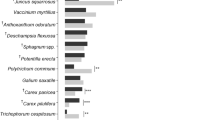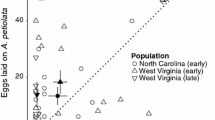Abstract
What is the role of time-constraints in determining geographical variation in the resource use of organisms? One hypothesis concerning phytophagous insects predicts a local narrowing of host plant range at localities where a short development time is important (because an additional generation per season is only just possible), with increased specialization on host plants permitting fast development. To test this hypothesis, populations of the polyphagous comma butterfly (Nymphalidae: Polygonia c-album) from five European areas (localities in Norway, Sweden, England, Belgium and Spain) were sampled and the preferences of laboratory-reared female butterflies were investigated, by a choice test between Salix caprea and the fastest host Urtica dioica. The results suggest that females of both of two northern univoltine populations (time-stressed from Norway and time-relaxed from Sweden) accept the slow host S. caprea to a higher degree than females of more southern populations with partial additional generations (time-stressed). We thus found partial support for the tested hypothesis, but also conflicting results that cast doubt on its broad generality. Moreover, a split-brood investigation on Swedish stock demonstrated that larval performance is similar on S. caprea and U. dioica early in the summer, but that later in the season S. caprea is a much inferior host. This is reflected by a seasonal trend towards specialization on U. dioica and also provides a simpler explanation than the time-constraints theory for avoidance of S. caprea (and other woody hosts) in areas with two or more generations of insects per year, illustrating the importance of plant phenology as a constraint on resource use in phytophagous insects. Absolute and relative larval performance on the two hosts varied little among populations across Europe, but lower survival on S. caprea in the populations most specialized on U. dioica and related plants may be indicative of performance trade-offs.




Similar content being viewed by others
References
Anonymous (1987) Tagfalter und ihre Lebensräume. Schweizerischer Bund für Naturschutz, Basel
Asher J, Warren M, Fox R, Harding P, Jeffcoate G, Jeffcoate S (2001) The millennium atlas of Britain and Ireland. Oxford University Press, Oxford
Ayres MP, MacLean SF Jr (1987) Development of birch leaves and the growth energetics of Epirrita autumnata (Geometridae). Ecology 68:558–568. doi:10.2307/1938461
Bergström A, Janz N, Nylin S (2006) Putting more eggs in the best basket: clutch-size regulation in the comma butterfly. Ecol Entomol 31:255–260. doi:10.1111/j.1365-2311.2006.00782.x
Braschler B, Hill JK (2007) Role of larval host plants in the climate-driven range expansion of the butterfly Polygonia c-album. J Anim Ecol 76:415–423. doi:10.1111/j.1365-2656.2007.01217.x
Burke S, Pullin AS, Wilson RJ, Thomas CD (2005) Selection for discontinuous life-history traits along a continuous thermal gradient in the butterfly Aricia agestis. Ecol Entomol 30:613–619. doi:10.1111/j.0307-6946.2005.00741.x
Cizek L, Fric Z, Konvicka M (2006) Host plant defences and voltinism in European butterflies. Ecol Entomol 31:337–344. doi:10.1111/j.1365-2311.2006.00783.x
Courtney SP (1982) Coevolution of pierid butterflies and their cruciferous foodplants V. Habitat selection, community structure and speciation. Oecologia 54:101–107. doi:10.1007/BF00541116
Doak P, Kareiva P, Kingsolver J (2006) Fitness consequences of choosy oviposition for a time-limited butterfly. Ecology 87:395–408. doi:10.1890/05-0647
Ebert G (1993) Die Schmetterlinge Baden-Württembergs. Verlag Eugen Ulmer, Stuttgart
Feder JL, Forbes AA (2007) Habitat avoidance and speciation for phytophagous insect specialists. Funct Ecol 21:585–597. doi:10.1111/j.1365-2435.2007.01232.x
Feeny P (1970) Seasonal changes in oak leaf tannins and nutrients as a cause of spring feeding by winter moth caterpillars. Ecology 51:565–581. doi:10.2307/1934037
Ferrari J, Godfray HCJ, Faulconbridge AS, Prior K, Via S (2006) Population differentiation and genetic variation in host choice among pea aphids from eight host plant genera. Evolution 60:1574–1584
Forbes AA, Fisher J, Feder JL (2005) Habitat avoidance: overlooking an important aspect of host-specific mating and sympatric speciation? Evolution 59:1552–1559
Futuyma DJ, Moreno G (1988) The evolution of ecological specialization. Annu Rev Ecol Syst 19:207–233. doi:10.1146/annurev.es.19.110188.001231
Janz N (1998) Sex-linked inheritance of host-plant specialization in a polyphagous butterfly. Proc R Soc Lond B Biol Sci 265:1–4. doi:10.1098/rspb.1998.0487
Janz N, Nylin S, Wedell N (1994) Host plant utilization in the comma butterfly: sources of variation and evolutionary implications. Oecologia 99:132–140. doi:10.1007/BF00317093
Janz N, Nyblom K, Nylin S (2001) Evolutionary dynamics of host-plant specialization: a case study of the tribe Nymphalini. Evolution 55:783–796. doi:10.1554/0014-3820(2001)055[0783:EDOHPS]2.0.CO;2
Janz N, Bergström A, Johansson J (2005) Frequency dependence of host plant choice within and between patches: a large cage experiment. Evol Ecol 19:289–302. doi:10.1007/s10682-005-6078-3
Janz N, Nylin S, Wahlberg N (2006) Diversity begets diversity: host expansions and the diversification of plant-feeding insects. BMC Evol Biol 6:4. doi:10.1186/1471-2148-6-4
Joshi A, Thompson JN (1995) Trade-offs and the evolution of host specialization. Evol Ecol 9:82–92. doi:10.1007/BF01237699
Maes D, Van Dyck H (1999) Dagvlinders in Vlaanderen – Ecologie, verspreiding en behoud. Stichting Leefmilieu, Brussel
Mousseau TA (1997) Ectotherms follow the converse to Bergmann’s rule. Evolution 51:630–632. doi:10.2307/2411138
Nosil P (2007) Divergent host plant adaptation and reproductive isolation between ecotypes of Timema cristinae walking sticks. Am Nat 169:151–162. doi:10.1086/510634
Nygren GH, Nylin S, Stefanescu C (2006) Genetics of host plant use and life history in the comma butterfly across Europe: varying modes of inheritance as a potential reproductive barrier. J Evol Biol 19:1882–1893. doi:10.1111/j.1420-9101.2006.01174.x
Nylin S (1988) Host plant specialization and seasonality in a polyphagous butterfly, Polygonia c-album (Nymphalidae). Oikos 53:381–386. doi:10.2307/3565539
Nylin S (1989) Effects of changing photoperiods in the life cycle regulation of the comma butterfly, Polygonia c-album (Nymphalidae). Ecol Entomol 14:209–218. doi:10.1111/j.1365-2311.1989.tb00771.x
Nylin S (1992) Seasonal plasticity in life history traits: growth and development in Polygonia c-album (Lepidoptera: Nymphalidae). Biol J Linn Soc 47:301–323. doi:10.1111/j.1095-8312.1992.tb00672.x
Nylin S, Svärd L (1991) Latitudinal patterns in the size of European butterflies. Holarctic Ecol 14:192–202
Nylin S, Nygren GH, Windig JJ, Janz N, Bergström A (2005) Genetics of host plant preference in the comma butterfly and its evolutionary implications. Biol J Linn Soc 84:755–765. doi:10.1111/j.1095-8312.2004.00433.x
Parmesan C (2006) Ecological and evolutionary responses to recent climate change. Annu Rev Ecol Evol Syst 37:637–669. doi:10.1146/annurev.ecolsys.37.091305.110100
Roff DA (1980) Optimizing development time in a seasonal environment: the ‘ups and downs’ of clinal variation. Oecologia 45:202–208. doi:10.1007/BF00346461
Roff DA (1983) Phenological adaptation in a seasonal environment: a theoretical perspective. In: Brown VK, Hodek I (eds) Diapause and life cycle strategies in insects. Dr W Junk Publishers, The Hague, pp 253–270
Scheirs J, De Bruyn L, Verhagen R (2002) Seasonal changes in leaf nutritional quality influence grass miner performance. Ecol Entomol 27:84–93. doi:10.1046/j.1365-2311.2002.0378a.x
Schluter D (2001) Ecology and the origin of species. Trends Ecol Evol 16:372–380. doi:10.1016/S0169-5347(01)02198-X
Scriber JM (2002) Latitudinal and local geographic mosaics in host plant preferences as shaped by thermal units and voltinism in Papilio spp. (Lepidoptera). Eur J Entomol 99:225–239
Scriber JM, Lederhouse RC (1992) The thermal environment as a resource dictating geographic patterns of feeding specialization of insect herbivores. In: Hunter MR, Ohgushi T, Price PW (eds) Effect of resource distribution on animal-plant interactions. Academic Press, NY, pp 429–466
Singer MC (2002) Spatial and temporal patterns of checkerspot butterfly-hostplant association: the diverse roles of oviposition preference. In: Boggs CL, Watt WB, Ehrlich PR (eds) Butterflies: ecology and evolution taking flight. The University of Chicago Press, Chicago, pp 207–228
Tauber MJ, Tauber CA, Masaki S (1986) Seasonal adaptations of insects. Oxford University Press, Oxford
Thompson JN (1988) Evolutionary ecology of the relationship between oviposition preference and performance of offspring in phytophagous insects. Entomol Exp Appl 47:3–14. doi:10.1007/BF00186709
Tolman T, Lewington R (1997) Collins field guide: Butterflies of Britain and Europe. HarperCollins Publishers Ltd., London
Via S, Hawthorne DJ (2005) Back to the future: genetic correlations, adaptation and speciation. Genetica 123:147–156. doi:10.1007/s10709-004-2731-y
Weingartner E, Wahlberg N, Nylin S (2006) Dynamics of host plant use and species diversity in Polygonia butterflies (Nymphalidae). J Evol Biol 19:483–491. doi:10.1111/j.1420-9101.2005.01009.x
Acknowledgments
We thank Hans Van Dyck for help with acquiring Belgian stock and Bertil Borg and an anonymous reviewer for useful comments on drafts. The manuscript is dedicated to the memory of Runar Krogen, devoted entomologist and fellow fan of Polygonia butterflies. Krogen delivered the Norwegian stock for this study and made important field and experimental observations used as background information. This study was supported by grants from the Swedish Research Council to SN.
Author information
Authors and Affiliations
Corresponding author
Rights and permissions
About this article
Cite this article
Nylin, S., Nygren, G.H., Söderlind, L. et al. Geographical variation in host plant utilization in the comma butterfly: the roles of time constraints and plant phenology. Evol Ecol 23, 807–825 (2009). https://doi.org/10.1007/s10682-008-9274-0
Received:
Accepted:
Published:
Issue Date:
DOI: https://doi.org/10.1007/s10682-008-9274-0




